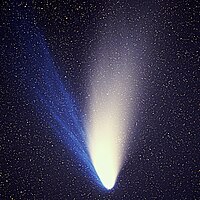
Photo from wikipedia
This paper aims to study the penetration effect of harpoons on space debris to ensure the sustainable development of the space environment and solve the increasingly serious space debris problem.… Click to show full abstract
This paper aims to study the penetration effect of harpoons on space debris to ensure the sustainable development of the space environment and solve the increasingly serious space debris problem. Firstly, a harpoon system was designed to capture space debris. Secondly, based on the Johnson–Cook dynamic constitutive model and fracture failure criterion, the finite element models of aluminum alloy plates were established. Then, the ballistic limit theory for the aluminum alloy target predicted the minimum launch velocity of the harpoon. Finally, the validation experiment was set up to verify the correctness of the model. The results show that the error between the simulation results of the speed for the harpoon embedded in the target and the theoretical results of the ballistic limit is 9.1%, which provides guidance for active space debris removal technology.
Journal Title: Materials
Year Published: 2022
Link to full text (if available)
Share on Social Media: Sign Up to like & get
recommendations!